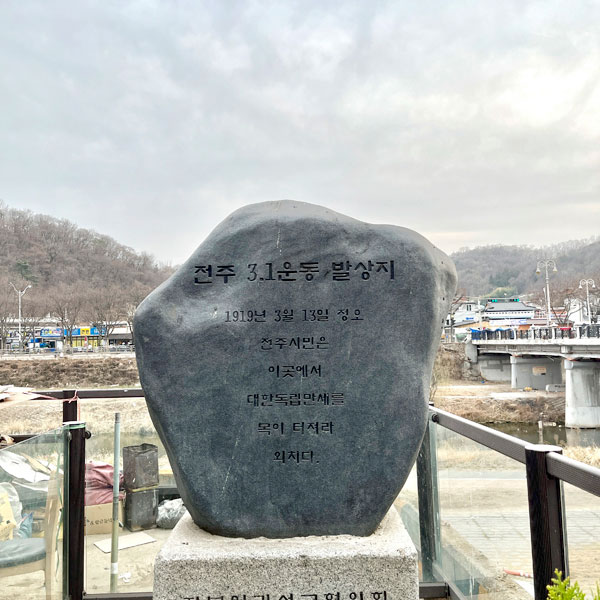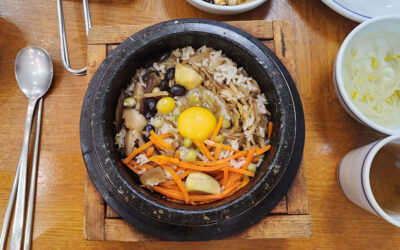Honouring the March 1st Movement: A Stroll Along the Path of Jeonju History – ‘The Traces of the Jeonju Independence Movement’

Honouring the March 1st Movement: A Stroll Along the Path of Jeonju History –
‘The Traces of the Jeonju Independence Movement’
Consider taking a peaceful stroll along Jeonju’s Independence Movement Trail to honour the March 1st Movement. You may also wish to visit the significant landmarks that commemorate the 104th anniversary of the establishment of the Provisional Government of the Republic of Korea on April 11th. The March 1st Movement in 1919 was a significant independence movement by the Korean people, which rejected Japan’s unauthorised rule and declared the independence of Korea. The establishment of the Provisional Government of the Republic of Korea in Shanghai, China, was a significant event that contributed to the spirit of the independence struggle.

As you make your way towards the Nambu Market, you will come across the Daga Bridge. At that time, the bridge was referred to as ‘Daegunggyo’ and served as a pathway to honour the Jeonju Shrine, situated at the top of Daga Mountain and the former location of the Sajikdan. The Daga Bridge holds significance as both a historical site of the Jeonju March 13th Independence Movement and a bridge that has been associated with feelings of humiliation.

Afterward, we had the opportunity to visit Nambu Market, where students from Shinheung School distributed Taegeukgi (Korean national flags) and Independence Declarations to citizens while passionately advocating for Korea’s independence. The market continues to thrive as a traditional market, and on Friday and Saturday evenings, it becomes a bustling night market that draws in not just locals from Jeonju, but also visitors from other places.


As you walk along the Jeonju Stream, you may encounter several significant historical landmarks, including the Jeonju Shinheung Middle and High School, which is the first one. The institution, formerly referred to as ‘Shinheung School,’ had a group of students who played a crucial role in opposing Japanese colonial rule through their leadership in student movements. These courageous students distributed Taegeukgi to citizens and led the Independence Movement. In recognition of their courageous spirit and selfless sacrifices, a monument that commemorates the Jeonju March 1st Movement has been erected at the main entrance of the school.

While passing by Daga Bridge and Nambu Market, we were filled with a deep sense of reverence as we remembered the brave students who risked their lives for Korea’s independence. On March 13th, 1919, a group of students from Shinheung School and Gijeon School created Taegeukgi and Independence Declarations in their school’s basement. They then quickly headed to the Nambu Market, where they distributed these documents to citizens and called out for Korea’s independence. A number of students were taken into custody and subsequently received prison sentences. Their commitment and selflessness for the nation, despite their youth, is admirable and deserving of our utmost respect.


The Shinheung School demonstrated bravery by providing support to the Gwangju Student Movement on November 3rd, 1929, and opposing Japan’s mandatory shrine worship, which ultimately resulted in the school’s closure.

As we headed along the streets where the students of Shinheung School once roamed, crafting Taegeukgi and raising their voices for independence, we were filled with a profound sense of appreciation for their selfless acts. We are grateful to them for their sacrifices, which have enabled us to live in a free and independent Korea today. We have made a solemn promise to always honour and remember their unwavering spirit.


The Daga Bridge and Nambu Market are significant historical sites that visitors can explore to gain knowledge about the sacrifices made during Korea’s struggle for independence. 


The vibrant traditional market continues to draw the attention of both tourists and locals, particularly during the lively night market on Fridays and Saturdays.

Finally, we had the opportunity to visit Hanbyeokdang, a beautiful pavilion that was carved out of a cliff and constructed in the year 1404.
This place has been visited by numerous poets and scholars, which has made it a significant symbol of the sophisticated culture of Jeonju scholars. The scenery around the Jeonju Stream is truly stunning and has earned it the nickname “Hanbyeokcheongyeon”. It is also recognised as one of the eight scenic spots in Jeonju.


Throughout its extensive history, Hanbyeokdang has been a location that inspires admiration for the rich cultural heritage of Jeonju. During the Japanese colonial period, scholar Choi Byeong-sim bravely resisted Japan’s attempt to tear down Hanbyeokdang by fasting. He expressed his strong commitment to Okgujeongsa by stating, “I would rather burn to death than give it up.”
Okgujeongsa is a private school that was established during the Japanese colonial period with the aim of preserving our spirit and cultural heritage while also nurturing future generations.
This spring, may I suggest taking a leisurely walk along the Jeonju Stream to admire the stunning natural surroundings and discover the historical significance of the independence movement?




최신 댓글